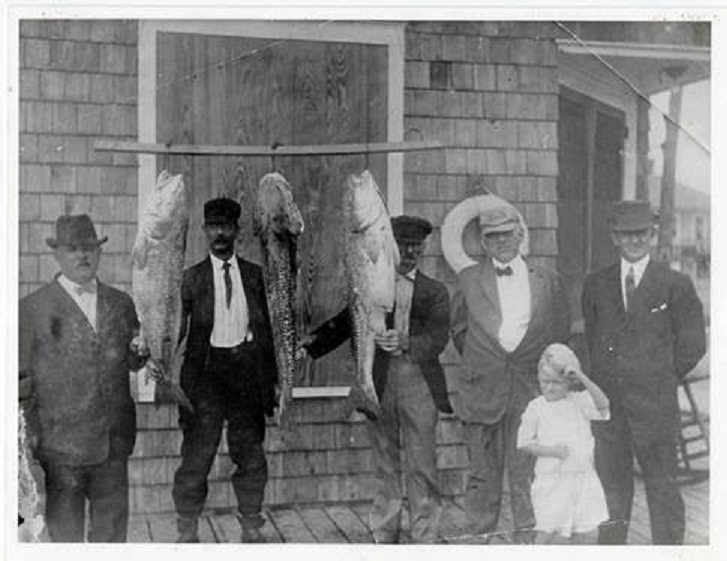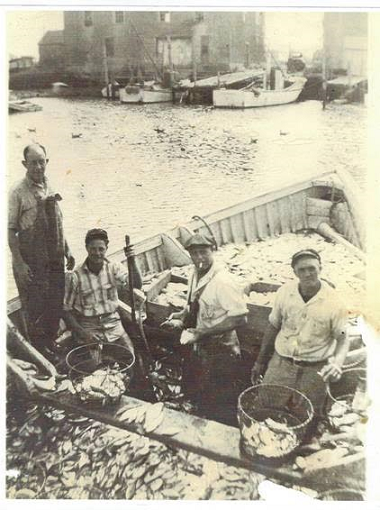The photo below of a 1777 map of Cape May County. Note how the barrier islands were defined as “Beaches” and Sea Isle was Ludlam Beach…
 1664 - 1880
When New Jersey was founded in 1664, it was divided into two parts, East and West. What was to become Sea Isle City was part of West Jersey, with Lord John Berkeley as proprietor, and Burlington as its first capital. In 1674, Berkeley sold his portion to a Quaker group, and the site of Sea Isle eventually passed to the Quaker organization "West Jersey Proprietors," which included William Penn as a trustee. It was this group that, in 1692, sold a barrier Island to Joseph Ludlam (a whaler-turned-farmer) who would use the land to graze his livestock. He proceeded to name the island after himself: "Ludlam's Beach."
Ludlam divided his Island into three parcels: the south, which he sold to John Townsend in 1695; the north, which eventually became Strathmere; and the largest central part, which would be sold by the Ludlam family to Charles Kline Landis in 1880 to create Sea Isle City.
While all this was going on, there were few permanent residents of Ludlam's Island. The peaceful Lenni Lenape tribe led by King Nummy (also known as the Delawares), came to the island from their summer camp in the Lake Magnolia area to hunt and fish, and to escape the summer heat. By 1735 most of the tribe had left Cape May County, although they inhabited parts of New Jersey for another 60 years.
Whalers, fishermen, and hunters made use of Ludlam's Island for their trades and to provide food for their families. The first buildings on the island were small cottages they used for temporary shelter. Captain William Kidd and other privateers were said to have stopped by to lay in wait for unsuspecting ships, and perhaps to bury their booty so they wouldn't have to turn it over to the Crown. We know that pirates visited Cape May County because pirate pistols have been found in the sand hills, and at one point the West Jersey government stepped in to warn farmers to stop trading with them.
1664 - 1880
When New Jersey was founded in 1664, it was divided into two parts, East and West. What was to become Sea Isle City was part of West Jersey, with Lord John Berkeley as proprietor, and Burlington as its first capital. In 1674, Berkeley sold his portion to a Quaker group, and the site of Sea Isle eventually passed to the Quaker organization "West Jersey Proprietors," which included William Penn as a trustee. It was this group that, in 1692, sold a barrier Island to Joseph Ludlam (a whaler-turned-farmer) who would use the land to graze his livestock. He proceeded to name the island after himself: "Ludlam's Beach."
Ludlam divided his Island into three parcels: the south, which he sold to John Townsend in 1695; the north, which eventually became Strathmere; and the largest central part, which would be sold by the Ludlam family to Charles Kline Landis in 1880 to create Sea Isle City.
While all this was going on, there were few permanent residents of Ludlam's Island. The peaceful Lenni Lenape tribe led by King Nummy (also known as the Delawares), came to the island from their summer camp in the Lake Magnolia area to hunt and fish, and to escape the summer heat. By 1735 most of the tribe had left Cape May County, although they inhabited parts of New Jersey for another 60 years.
Whalers, fishermen, and hunters made use of Ludlam's Island for their trades and to provide food for their families. The first buildings on the island were small cottages they used for temporary shelter. Captain William Kidd and other privateers were said to have stopped by to lay in wait for unsuspecting ships, and perhaps to bury their booty so they wouldn't have to turn it over to the Crown. We know that pirates visited Cape May County because pirate pistols have been found in the sand hills, and at one point the West Jersey government stepped in to warn farmers to stop trading with them.
 “A Fine Catch” Circa Early 1900’s: Local Sea Isle City men gather to congratulate the Fishermen. The building in the background is Hotel Stevens located on the Boardwalk and Italia Street (now 42nd Street); It was later known as, Hotel Windsor. The fish were caught at Ocean Pier on the Boardwalk. Sea Isle Gentlemen are, Mr. Sannino (Mary Monichetti’s Father), Mr. Shaefer, Mr. Harrington, Mr. Stevens and Eddie and Charles Camp…
During the early days, sailing along the Jersey coast was extremely hazardous; there were no buoys or lighthouses. Many shipwrecks were reported off Ludlam's Island. In 1809 the British ship "Guatamoozin" was grounded, and her seamen rescued by local fishermen. The brig "Mortimer Livingston" ran ashore with 300 German and French immigrants, all of whom were rescued and taken to the mainland. Lifesaving stations began to be constructed around 1850, the earliest being a station at Townsends Inlet, probably at the site of the current Coast Guard Station at 81st Street.
The topography of the island was different from what it is today. There were ten to twelve foot high sand hills along the beach front, with the highest hills from 80th to 84th Streets - still the highest point on the island. The island was covered with a lush growth of cedar, holly and other trees, and a variety of grasses. The west side was, and still is, primarily meadowland.
In 1702, East and West Jersey were combined under the authority of Queen Anne to become the single colony of New Jersey. On December 18, 1787, New Jersey became a state. Many of the activities cited above continued well into the 19th century, e.g., cattle still grazed on Ludlam's Island as late as 1875. But there were still few permanent residents of the future Sea Isle. This was all to change when Charles Kline Landis entered the scene in 1880.
“A Fine Catch” Circa Early 1900’s: Local Sea Isle City men gather to congratulate the Fishermen. The building in the background is Hotel Stevens located on the Boardwalk and Italia Street (now 42nd Street); It was later known as, Hotel Windsor. The fish were caught at Ocean Pier on the Boardwalk. Sea Isle Gentlemen are, Mr. Sannino (Mary Monichetti’s Father), Mr. Shaefer, Mr. Harrington, Mr. Stevens and Eddie and Charles Camp…
During the early days, sailing along the Jersey coast was extremely hazardous; there were no buoys or lighthouses. Many shipwrecks were reported off Ludlam's Island. In 1809 the British ship "Guatamoozin" was grounded, and her seamen rescued by local fishermen. The brig "Mortimer Livingston" ran ashore with 300 German and French immigrants, all of whom were rescued and taken to the mainland. Lifesaving stations began to be constructed around 1850, the earliest being a station at Townsends Inlet, probably at the site of the current Coast Guard Station at 81st Street.
The topography of the island was different from what it is today. There were ten to twelve foot high sand hills along the beach front, with the highest hills from 80th to 84th Streets - still the highest point on the island. The island was covered with a lush growth of cedar, holly and other trees, and a variety of grasses. The west side was, and still is, primarily meadowland.
In 1702, East and West Jersey were combined under the authority of Queen Anne to become the single colony of New Jersey. On December 18, 1787, New Jersey became a state. Many of the activities cited above continued well into the 19th century, e.g., cattle still grazed on Ludlam's Island as late as 1875. But there were still few permanent residents of the future Sea Isle. This was all to change when Charles Kline Landis entered the scene in 1880.
_______________________________________________________________
 Mr. Lou Bufalo, (in stripped shirt) along with fellow fishermen are shown admiring their bounty after a day of pound-fishing. Though hardly as glamorous as today’s resort industry, pound-fisherman trapped large quantities of fish in massive nets. It was a major part of Sea Isle City’s economy from the mid-19th through the mid- 20th century. The building shown in the background of the photo below is the old fishing warehouse in Fish Alley that today is known as The Lobster Loft Restaurant…
Local Sea Isle City men gather to congratulate the Fishermen. The building in the background is Hotel Stevens located on the Boardwalk and Italia Street (now 42nd Street); It was later known as, Hotel Windsor. The fish were caught at Ocean Pier on the Boardwalk. Sea Isle Gentlemen are, Mr. Sannino (Mary Monichetti’s Father), Mr. Shaefer, Mr. Harrington, Mr. Stevens and Eddie and Charles Camp…
Do you love History and have knowledge of computers? The Sea Isle City Historical Museum is looking for volunteers who can help with the museum’s website.
Please visit the Sea Isle Museum at 48th Street and Central Avenue (on the first floor of the Sea Isle City Library). Access our website at www.seaislemuseum.com for museum hours and more information. Call 609-263-2992 with any questions.
Mr. Lou Bufalo, (in stripped shirt) along with fellow fishermen are shown admiring their bounty after a day of pound-fishing. Though hardly as glamorous as today’s resort industry, pound-fisherman trapped large quantities of fish in massive nets. It was a major part of Sea Isle City’s economy from the mid-19th through the mid- 20th century. The building shown in the background of the photo below is the old fishing warehouse in Fish Alley that today is known as The Lobster Loft Restaurant…
Local Sea Isle City men gather to congratulate the Fishermen. The building in the background is Hotel Stevens located on the Boardwalk and Italia Street (now 42nd Street); It was later known as, Hotel Windsor. The fish were caught at Ocean Pier on the Boardwalk. Sea Isle Gentlemen are, Mr. Sannino (Mary Monichetti’s Father), Mr. Shaefer, Mr. Harrington, Mr. Stevens and Eddie and Charles Camp…
Do you love History and have knowledge of computers? The Sea Isle City Historical Museum is looking for volunteers who can help with the museum’s website.
Please visit the Sea Isle Museum at 48th Street and Central Avenue (on the first floor of the Sea Isle City Library). Access our website at www.seaislemuseum.com for museum hours and more information. Call 609-263-2992 with any questions.